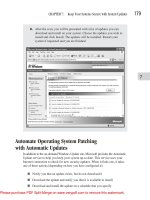How to Do Everything with Web 2.0 Mashups phần 6 potx
Bạn đang xem bản rút gọn của tài liệu. Xem và tải ngay bản đầy đủ của tài liệu tại đây (1.69 MB, 33 trang )
148 How to Do Everything with Web 2.0 Mashups
If you download census data in this way, you will have text data delimited with | between
each field. The beginning of the file is shown in Figure 11-8. Look at the beginning of the file
before you begin to load the data into a database so that you know what you are dealing with.
The Labor Force Data
The data from the Bureau of Labor Statistics (BLS) are reachable from the main site at http://
www.bls.gov. Go to the State and Local Unemployment Rates page at />home.htm, as shown in Figure 11-9.
If you scroll down that page, you can find the county data available for download, as you can
see in Figure 11-10.
The data used in this mashup are the first data set, the county data for 2005. You can download
them as text, which is basically the same process as you saw for the census data. If you choose
to download the zipped archives, you get an Excel spreadsheet with the data. You can open it in
FIGURE 11-3
Select Summary File 1 (SF1)
Simpo PDF Merge and Split Unregistered Version -
CHAPTER 11: Implement a Basic Mashup 149
Excel, and then save it as a comma-separated value (CSV) file or a tab-delimited text file (which
is what was done in this example). The Excel spreadsheet contains column headings describing
the data. Before saving the spreadsheet as a tab-delimited file, delete the heading rows from the
spreadsheet.
The beginning of the data file is shown in Figure 11-11, after it was saved as a tab-delimited
file.
Some applications “help” you when saving comma- or tab-delimited data. In particular,
they may insert commas into numeric values. If at all possible, save the data as a text
file, not as a spreadsheet where such formatting may come back to haunt you. If you are
using a spreadsheet, you might want to change the column cell formatting to numeric
with no commas to make the data as plain as possible for their later import into MySQL.
FIGURE 11-4
Select the level of detail
11
Simpo PDF Merge and Split Unregistered Version -
150 How to Do Everything with Web 2.0 Mashups
Get Access to the Data
Now that you have selected the data and downloaded them, you need to load them into MySQL.
Launch MySQL as described in Chapter 7, and then create a new database to use for your
mashups. In this book’s code, the database is called mashups_sql, but you can name it anything
you want. (Using the same database, table, and column names may make it easier to reuse the
code.)
There will be two tables: one for the population data and one for the labor force data. You
could merge the data at this point, but that would make the mashup somewhat irrelevant. The
database structure assumed you will dynamically join the two tables, based on the user’s mashup
request.
FIGURE 11-5
Select your data
Simpo PDF Merge and Split Unregistered Version -
CHAPTER 11: Implement a Basic Mashup 151
FIGURE 11-6
Confirm the download
FIGURE 11-7
Decide what to do with the data
11
Simpo PDF Merge and Split Unregistered Version -
152 How to Do Everything with Web 2.0 Mashups
Load Labor Force Data into MySQL
The labor force data are a little easier to load than the population data, so they are the first to
be loaded. There are two steps: creating the table and loading the data. These processes were
described in Chapter 7. This section provides you with the specific code to use with these data
sources.
Create the Table
This table will contain all the fields from the data file. The first step is to create a table with all
the fields from the data file. Putting them in the same order makes loading easier.
create table labor_force (
LAUS_Code varchar (25),
State_FIPS_Code Varchar (2),
County_FIPS_Code Varchar (3),
County_Name Varchar (60),
year varchar (4),
blankcol varchar (10),
labor_force mediumint unsigned,
employed mediumint unsigned,
unemployed mediumint unsigned,
rate float);
FIGURE 11-8
The downloaded data file
Simpo PDF Merge and Split Unregistered Version -
CHAPTER 11: Implement a Basic Mashup 153
Load the Data
Because you are loading all the fields in sequence, the load data command merely needs to
specify the input file and the field terminator (the tab character). Note, the fully qualified file
name includes some spaces that are escaped with a \. Depending on where you downloaded the
file, your file name and path may differ. The file name in this example is
Users
jfeiler
Documents
Projects
CurrentProjects
Mashups
Labor force by county 2005
laucnt05.txt
FIGURE 11-9
Go to the state and local unemployment rates page
11
Simpo PDF Merge and Split Unregistered Version -
154 How to Do Everything with Web 2.0 Mashups
FIGURE 11-10
Select county data
FIGURE 11-11
Save the Excel file as tab-delimited text
Simpo PDF Merge and Split Unregistered Version -
CHAPTER 11: Implement a Basic Mashup 155
Here is the command to use:
load data infile local
/Users/jfeiler/Documents/Projects/CurrentProjects/
Mashups/Labor\ force\ by\ county\ 2005/laucnty05.txt
into table labor_force
fields terminated by '\t';
When the data are loaded, look at them in MySQL (remember to use the LIMIT clause), as
shown in Figure 11-12. (If your data do not load properly, review the section in Chapter 7 on loading
a database. Pay attention to the “lines terminated by” clause, which is frequently the culprit.)
Load Population Data into MySQL
This step consists of creating a table, and then loading the data into it.
Create the Population Table
You need to create a table for the population data from the Census Bureau. More information is
in the downloaded file than you need, so your table only needs to have the state and county FIPS
codes, and the population. The table created has total population, as well as population by sex. It
also has the country name field in it.
Note, when you access the data, you are performing a join on the population and labor force
tables. You need to be able to display the county name, so it must be available in one (or both)
of those tables or in a separate table joined to them. In this database design, the county name is
provided in both tables, so that either can be reused in other contexts. As a result, the data are not
normalized, because the combination of state/county/country name is repeated.
FIGURE 11-12
Review the loaded data
11
Simpo PDF Merge and Split Unregistered Version -
156 How to Do Everything with Web 2.0 Mashups
Here is the MySQL code to create the population table:
create table population (
State_FIPS_Code varchar (2),
County_FIPS_Code varchar (3),
County_Name Varchar (60),
TotalPopulation mediumint (8),
TotalMen mediumint (8),
TotalWomen mediumint (8));
Load the Population Data
First, refer to Figure 11-8 to look at the actual data. Note, two records are at the beginning of the
file that should not be loaded. The first contains field names (such as GEO_ID , GEO_ID2, and
P012016). The second contains more readable field names with spaces in them.
When you come to the third record, which is the beginning of the actual data, notice the
fields do not map perfectly into the database table. Not only are the age and sex breakdowns
omitted, but the first geography identifier (the value 05000US01001 in the first record) is not
used, and the second geography identifier (the value 01001 in the first record) contains both
the state and county FIPS codes. (You can determine this from reading the documentation and
looking in the geo file, which is part of the download package.)
Thus, the load data command not only needs to specify the basics of what table is to be
loaded with what data file, but also:
■ how the fields are delimited
■ how the records are delimited
■ that the first two records are to be ignored
■ some data munging needs to be done
Chapter 7 describes how to do these manipulations. Here is the actual load data command
to use:
load data infile local
'/Users/jfeiler/Desktop/dc_dec_2000_sf1_u_data1.txt'
into table population
fields terminated by '|'
lines terminated by '\n'
ignore 2 lines
(@var1, @geocode, @var2, County_Name,
TotalPopulation, TotalMen, TotalWomen)
set State_FIPS_Code=left(@geocode, 2),
County_FIPS_Code=right(@geocode, 3);
Simpo PDF Merge and Split Unregistered Version -
CHAPTER 11: Implement a Basic Mashup 157
Once you load the table, you can check it by retrieving data, as shown in Figure 11-13. Note,
the LIMIT clause prevents too much output.
Test
Before continuing, check to see if the data are working the way you want them to. You already
looked at each table, but use MySQL to type in a query that performs a join, as shown in
Figure 11-14. A lot of redundant data are here because the test is to make certain you are picking
up the correct values from each table.
Once you are certain your joins work, you can ignore the redundant data, as shown in
Figure 11-15.
FIGURE 11-13
Look at the loaded data
FIGURE 11-14
Check that the database functions as you expect it to
11
Simpo PDF Merge and Split Unregistered Version -
158 How to Do Everything with Web 2.0 Mashups
Regroup
After loading the data and testing the database, you may need to regroup. Perhaps the keys do
not match up. Perhaps you have two different levels of granularity in the data. This is the time to
confirm that the data side of the mashup works.
Design the User Interface
Most mashups have two main components: a start page and a page that displays the result of the
mashup. It makes sense not to design the interface until after you have tested (and regrouped).
As you experiment with the data, you may discover you need more or fewer input fields for the
user. In this case, it is clear you need the user to specify the county and the state. For the purpose
of this mashup, those are specified by numbers. You can use PHP to populate selection lists, so
the user can choose states and counties. Or, the start page might have a list of counties and states.
Whatever you do, you need to pass the county and state to the mashup.
Implement the Mashup
Even though you have tested, until the mashup runs, you may need to change the interface to add
or remove data elements that need to be passed to the mashup. For this reason, it is easier to start
by programming the mashup.
FIGURE 11-15
Retest with only the columns you care about
Simpo PDF Merge and Split Unregistered Version -
CHAPTER 11: Implement a Basic Mashup 159
Using the principles outlined in Chapter 7, this mashup uses include files for the top and
bottom of the page. Here are the include files. First, PageTop.html. Note, it is incomplete and
relies on the main script to complete its elements.
<?xml version="1.0" encoding="iso-8859-1"?>
<!DOCTYPE html PUBLIC "-//W3C//DTD XHTML 1.0 Transitional//EN"
" /> <html xmlns=" /> <head>
<title><?php echo $page_title; ?></title>
<meta http-equiv="Content-Type" content="text/html;
charset=iso-8859-1" />
</head>
<body>
<h1 align="center">Jesse Feiler's Mashups Book</h1>
<h1 align="center"><?php echo $page_title;?></h1>
<br>
Next is the MySQLLogin.php script. You need to customize this script for your user name
and password. You may also need to customize it for your host and database names.
<?php
$DB_User = 'yourUserName';
$DB_Password = 'yourPassword';
$DB_Host = 'localhost';
$DB_Name = 'mashups_sql';
$dbc = @mysql_connect ($DB_Host, $DB_User, $DB_Password) or
die ('Could not connect to MYSQL:'.mysql_error());
@mysql_select_db ($DB_Name) or
die ('Could not select the database:'.mysql_error());
?>
At the bottom of the main script, include MySQLLogout.php:
<?php
mysql_close(); // Close the database connection.
?>
And, finally, PageBottom.html closes the page:
<br>
<p>Copyright (c) 2007 Jesse Feiler,
North Country Consulting. All Rights Reserved.
11
Simpo PDF Merge and Split Unregistered Version -
160 How to Do Everything with Web 2.0 Mashups
</p>
<p>For information, contact
<a href="mailto:">
Jesse Feiler
</a>.
</p>
</body>
</html>
Testing the script at this stage makes sense. Here is how you can create the script so dummy
text is displayed. If this does not work, in most cases, something is wrong with an include file.
Check spacing, punctuation, and so forth. If you do not quickly see the problem, remove code
until you get to an absolutely bare-bones page that works. Then begin adding in code until you
find the problematic line. This test version of the file performs no database accesses, so you can
safely remove the login and logout files, if necessary, for testing.
All this page does is display the word test, as well as the headers and footers. You can test
it by putting it in your Sites folder (or wherever your Web server documents are kept), and then
typing in its name. Remember to terminate the name with .php.
<?php
$page_title = "Chapter 11";
include ('./Includes/PageTop.html');
include ('./Includes/MySQLLogin.php');
$resultText = 'test';
echo $resultText;
include ('./Includes/MySQLLogout.php');
include ('./Includes/PageBottom.html');
?>
If this works, you can add the database call. For now, you can hard-code the state and county,
as shown in the underlined code. The query has been split onto several lines for readability on
the page, as well as in the actual code. It can be written more compactly with the “here is” style
described in Chapter 6. If the query fails, you can remove some of the AND clauses. You will
get more data back without the qualifications of the AND clauses you remove, but you hone
in on the syntax errors. Note, also, the query itself is echoed back, so you can see what you are
constructing and debug it that way.
<?php
$page_title = "Chapter 11";
include ('./Includes/PageTop.html');
include ('./Includes/MySQLLogin.php');
Simpo PDF Merge and Split Unregistered Version -
CHAPTER 11: Implement a Basic Mashup 161
// Query the database.
$state = 1;
$county = 1;
$query = "SELECT population.County_Name, TotalPopulation,
labor_force ";
$query .= " FROM population, labor_force ";
$query .= " WHERE (population.State_FIPS_Code = '".$state."')";
$query .= " AND ";
$query .= " (labor_force.State_FIPS_Code = '".$state."')";
$query .= " AND ";
$query .= " (population.County_FIPS_Code = '".$county."')";
$query .= " AND ";
$query .= " (labor_force.County_FIPS_Code = '".$county."')";
$query .= " LIMIT 10";
echo $query;
$result = mysql_query ($query);
// Get the data.
$row = mysql_fetch_array ($result, MYSQL_NUM);
$CountyName = $row[0];
$Population = $row[1];
$WorkForce = $row[2];
$resultText = $CountyName." population=".$Population.",
work force=".$WorkForce;
echo $resultText;
include ('./Includes/MySQLLogout.php');
include ('./Includes/PageBottom.html');
?>
Once this works, remove the echo of $query, and remove the hard-coding of the state and
county. You pick them up from fields in a form, so change those lines as follows:
$state = $_REQUEST['state'];
$county = $_REQUEST['county'];
11
Simpo PDF Merge and Split Unregistered Version -
162 How to Do Everything with Web 2.0 Mashups
Implement the Starting Page
The last step is to implement the starting page. You need a form that calls the php script and has
fields for the state and county. Here is that file with the customizations for this particular mashup
underlined:
<?xml version="1.0" encoding="iso-8859-1"?>
<!DOCTYPE html PUBLIC "-//W3C//DTD XHTML 1.0 Transitional//EN"
" /> <html xmlns=" /> <head>
<title>Chapter 11</title>
<meta http-equiv="Content-Type" content="text/html;
charset=iso-8859-1" />
</head>
<body>
<h1 align="center">Jesse Feiler's Mashups Book</h1>
<h1 align="center">Chapter 11</h1>
<form name="form1" id="form1" method="post"
action="GetBLSCensusData.php">
<p align="center"><font size="-1">Select state for data retrieval:
<input name="state" type="text" id="state" size="10"/>
</font>
</p>
<p align="center"><font size="-1">Select county for data retrieval:
<input name="county" type="text" id="county" size="10"/>
</font>
</p>
<p align="center"><font size="-1">
<input type="submit" name="Submit" value="Look Up" />
</font>
</p>
</form>
<p><font size="2">Copyright (c) 2007 Jesse Feiler,
North Country Consulting. All Rights Reserved.
For information, contact
<a href="mailto:">
Jesse Feiler</a>.
</font>
</p>
</body>
</html>
Simpo PDF Merge and Split Unregistered Version -
Chapter 12
Use the Google Maps API
Simpo PDF Merge and Split Unregistered Version -
164 How to Do Everything with Web 2.0 Mashups
How to . . .
■ Get Access to the Google Maps API
■ Create the Basic Mapping Page
■ Create a Map
■ Identify a Location with a GLatLng
■ Use a Geocoder
■ Create a Marker
■ Add Text to a Marker
■ Wrap It Up in PHP
T
he remaining chapters in this book are in pairs: the first of each pair discusses a specific
mashup technology, such as Google maps, and the second walks you through the process of
creating a mashup using that technology, as well as the technologies described in Part II.
For many people, mashups started with the Google Maps API. Other mapping APIs are
available today, including Yahoo! Maps Web services, at
(Yahoo! APIs are discussed in Chapters 16 and 17, which explore the Flickr site.) All mapping
APIs are basically the same: they take a location and plot it on a map. A marker can be used to
pinpoint the location, and you can add text to the marker. The maps can be zoomed and moved
around. You can also generally switch between maps, aerial or satellite photos, and composite
maps.
Maps are a powerful tool for visualizing information. In addition to the location of a site, a map
can easily show clusters of data, which is the case of the political contributions mashup shown in
the following chapter. Geographic clusters are not always evident from text data—nearby locations
may be in different states or ZIP codes, but the little markers on a map unambiguously show
clusters of data.
Get Access to the Google Maps API
The first step to using the Google Maps API is to go to and
click the link to sign up for a Google Maps API key, as shown in Figure 12-1.
Previously in this book, you saw how to access sites with public data, so you have not
needed keys to download data. In the case of APIs, you generally need a key to enable you to use
the API. Terms of service exist to which you must agree for the use of the key. Although most
of these APIs are available without payment for many purposes, certain high-volume uses and
other cases require payments. The keys are unique to you, your application, or even the URL
from which your mashup is launched. If you are using the Google Maps API in several mashups
located on different servers, you may need different keys. Because using a key has no charge,
this is not a problem.
Simpo PDF Merge and Split Unregistered Version -
CHAPTER 12: Use the Google Maps API 165
In code samples throughout this book, you can see references to yourKey. This is
always a placeholder for the API key you need to register for.
When you click the link to sign up for a Google Maps API, you are prompted to agree to the
terms of service and to specify the URL for the Web site on which the key is to be used. After you
click the submit button, you see a confirmation screen with your key on it, as shown in Figure 12-2.
The key is a long string of numbers and characters. Carefully copy-and-paste it into a secure
location, so you can find the key when you need it. Also on this page is the URL for which the
key is valid, as well as some sample code in a box. Copy the sample code, and then paste it into
a blank HTML document.
Immediately save the HTML document and place it in your Web folder, either on a server or
on your local computer, and then attempt to open it in a browser, as shown in Figure 12-3.
FIGURE 12-1
Sign up for a Google Maps API key
12
Simpo PDF Merge and Split Unregistered Version -
166 How to Do Everything with Web 2.0 Mashups
Do not make any changes to the code you paste into the document: it should run exactly as
is. If it does not, troubleshoot the problem now: magic does not happen in the world of software.
One potential problem is something may be wrong with your publishing environment. If you
have not published an HTML page to that server or directory, take an existing page (or create
something such as a standard “Hello World” page) and verify that you can publish it. Check
that your browser is current and that JavaScript is not turned off in the browser. Then, go to the
Google Maps API site ( and look in the documentation and
discussions to see if you can find any information. Failing that, participate in a discussion and
pose your question. You must get past this basic point to proceed.
FIGURE 12-2
API key confirmation screen (with API key data erased)
Simpo PDF Merge and Split Unregistered Version -
CHAPTER 12: Use the Google Maps API 167
Create the Basic Mapping Page
The code you have just run is the most basic mapping code. In addition to the normal beginning
and ending code, three sections appear in every mapping page you create:
■ You include the basic Google mapping script
■ You write your own script to manipulate your map and data
■ You write the HTML that will display the map
Here is the complete sample code with annotations to show you what is happening. The code
begins with standard HTML document headers, as shown here. The only two changes made in
this code are the addition of a title for the page and the obscuring of the actual key value.
FIGURE 12-3
Try the Google Maps API sample code.
12
Simpo PDF Merge and Split Unregistered Version -
168 How to Do Everything with Web 2.0 Mashups
<!DOCTYPE html PUBLIC "-//W3C//DTD XHTML 1.0 Strict//EN"
" /> <html xmlns=" /> <head>
<meta http-equiv="content-type" content="text/html;
charset=utf-8"/>
<title>Test localhost API</title>
Next, you include a script element, which is an external script loaded with the src attribute.
Note, the src attribute loads the script from the maps.google.com server. It includes the version
number and, most important, your unique Google maps key. This script element is used exactly
as is for all the HTML documents that use this key (that is, all the HTML documents that will
reside in the domain for which you registered the key). This script contains all the code to
manipulate the maps from the Google side.
<script
src=" /> key=yourKey"
type="text/javascript">
</script>
Next, you write a script of your own, which is normally written directly into the page,
although you could include it with the src attribute from another location you control. The
important point is this is your script, and not Google’s script.
<script type="text/javascript">
//<![CDATA[
function load() {
if (GBrowserIsCompatible()) {
var map = new GMap2(document.getElementById("map"));
map.setCenter(new GLatLng(37.4419, -122.1419), 13);
}
}
//]]>
</script>
In the example script, a single function tests for browser compatibility, and then creates a
map in the element called map, which is accessed with the document.getElementById function.
This is the code you will change and expand for your own purposes. In the remainder of this
chapter, you find the primary functions and classes you use in your own script.
Simpo PDF Merge and Split Unregistered Version -
CHAPTER 12: Use the Google Maps API 169
Following the script is the end of the head element and the body element. In the body element,
the onload handler is set to the function declared in your script. The onunload handler is set to a
Google function, GUnload, that releases memory. In your mapping scripts, you normally call the
GUnload function and, most often, you call your own load function.
Finally, a div element with a named id (map) and a given size is declared. Note, in the load
function, document.getElementById is used to access this HTML element. You name graphical
elements in the body of your HTML code and access them in this way from your script.
</head>
<body onload="load()" onunload="GUnload()">
<div id="map" style="width: 500px; height: 300px"></div>
</body>
</html>
Create a Map
The Google Maps API documentation is located at />documentation/. Examples and discussions are there, as well as sample code. The heart of
the documentation is the API documentation itself, and the most important part of that is the
documentation of the GMap2 class. You have already seen the most basic code for creating a
map: you call a constructor to create a map. Next, you usually center the map on a particular
location. Here is the code from the example that creates the map:
var map = new GMap2(document.getElementById("map"));
The map you create is normally stored in a variable because you need to access it throughout
your script. In the example, the variable is local to the load function. In the examples you see
in the next chapter, as well as in your own mashups, the variable into which you place the map
is likely to be global to your script, so you can access it repeatedly as you process data. The
constructor for a GMap2 object takes, at the least, an HTML container into which the map is
placed. Normally, that is a div element, which is identified with an id attribute. Options are
described in the Google documentation, but this is sufficient for most cases.
When you create a map, you often add controls to it. The most common controls are map
controls and maptype controls. The map control is the set of controls that lets you move up or
down by clicking arrows, as well as zoom in or out by clicking the + or − control. The maptype
control lets you choose among map, satellite, or hybrid maps. To add these controls to a map, as
soon as it is created, issue these calls:
map.addControl (new GSmallMapControl());
map.addControl (new GMapTypeControl());
12
Simpo PDF Merge and Split Unregistered Version -
170 How to Do Everything with Web 2.0 Mashups
You have other choices than these. Instead of GSmallMapControl, you can add
GLargeMapControl. Or, you can use a GSmallZoomControl, which has only the zoom buttons or
a GScaleControl. The best way to familiarize yourself with these is to experiment. Many people
start with and stay with the GSmallMapControl, as shown here.
Identify a Location with a GLatLng
After you create the map in the example, you need to set its center point. The code that sets its
center point is shown here:
map.setCenter(new GLatLng(37.4419, -122.1419), 13);
The setCenter method takes a single parameter, which is a point on the Earth expressed in
latitude and longitude. This is a GLatLng object that is constructed inline in this code. The code
in the example is equivalent to writing the following two lines of code:
var myLatLng = new GLatLng(37.4419, -122.1419)
map.setCenter (myLatLng, 13);
The setCenter method requires a GLatLng object as its first parameter. It may optionally
have a zoom factor (13, in the example) and a map type. In the next chapter’s examples, you see
how to set other zoom factors.
Now you have seen the basics: how to create a map, how to create a GLatLng object
identifying a location on Earth, and how to center the map.
Use a Geocoder
Latitude and longitude are the generally accepted ways of identifying a point on the Earth’s
surface. But, in much of the data you want to map, you do not have those values. This is where
geocoding comes in. A geocoder converts an address to latitude and longitude. If you are going
to do that, you need to create a GClientGeocoder object in your script. You need only one such
object, and you can reference it as you need to while your script runs. If you need a geocoder,
you typically create it when you initialize the map (usually in a load function). Thus, the standard
code for a load function may look like this:
function load() {
if (GBrowserIsCompatible()) {
map = new GMap2(document.getElementById("map"));
map.setCenter(new GLatLng(37.4419, -122.1419), 13);
geocoder = new GClientGeocoder();
}
}
Simpo PDF Merge and Split Unregistered Version -
CHAPTER 12: Use the Google Maps API 171
Two variables are accessible from anywhere in the script. They should be declared at the
beginning of your script as follows:
<script type="text/javascript">
//<








